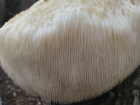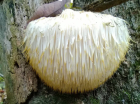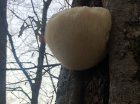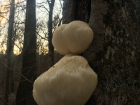Fruiting body consists of a single, unbranched cluster of soft spines that are 1–4 cm long. These spines hang from a sturdy, concealed base, which is attached to the tree. In mature specimens, the top of the fruiting body often exhibits shortened spines, giving it a hairy appearance. The spines themselves are initially white but may turn brownish to yellowish as they age. Stem very short if present. Spore print white.
Microscopic Features: The spores are broadly ellipsoidal to subglobose in shape, with a smooth or very slightly roughened surface. They measure approximately 5-6 x 4-5.5µm and are amyloid.
Hericium erinaceus on the MushroomExpert.Com Web site.
Hericium erinaceus on the www.first-nature.com web site.
Many mushrooms are poisonous, and some can be lethally toxic. Distinguishing between edible and poisonous mushrooms can be very challenging. Therefore, we strongly advise against consuming wild mushrooms. This website does not contain any information about the edibility or toxicity of mushrooms.
Although efforts have been made to ensure accuracy on this website, the information may contain errors and omissions. Therefore, all content provided is for educational and informational purposes only and should not be relied upon or used as a basis for consuming any plants or mushrooms.
External links are provided for reference only. We do not endorse or take responsibility for the content, advice, or products found on these sites or in any advertisements shown on this website.



